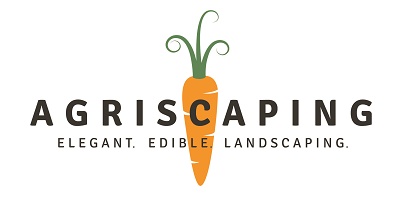Agriscaping Secrets for Desert Gardening: How to Select the Perfect Plants

Desert gardening may sound challenging, but with the right approach, you can transform your outdoor space into a lush and productive oasis. Agriscaping, the elegant blend of traditional landscaping and productive agriculture, offers a sustainable way to maximize the potential of your yard. By carefully selecting the right mix of edible and ornamental plants, you can create a stunning, eco-friendly landscape that thrives even in the challenging conditions of the desert southwest.
In this blog post, we’ll explore key tips for choosing the right plants for your desert garden, understanding microclimates, and integrating agriscaping principles for a vibrant, productive yard.

Understanding Agriscaping
Agriscaping combines the beauty of ornamental landscaping with the functionality of agricultural gardening. The goal is to create a landscape that not only looks beautiful but also produces fresh, edible fruits, vegetables, and herbs while conserving resources.
Key Benefits of Agriscaping
- Sustainability: Reduce water usage and landfill waste by growing drought-tolerant plants and composting garden waste.
- Health: Enjoy fresh, organic produce straight from your yard.
- Aesthetic Appeal: Combine the beauty of traditional landscaping with the charm of edible plants for a stunning visual effect.
- Cost Savings: Cut down on grocery bills by growing your own produce.
To make agriscaping successful in the desert southwest, choosing the right plants is essential.

Tips for Choosing the Right Plants for Desert Gardening
1. Focus on Drought-Tolerant Plants
Desert gardening requires plants that can withstand high temperatures and limited water. Opt for drought-tolerant varieties that thrive in the desert climate.
Top Drought-Tolerant Choices:
- Edible Plants: Pomegranates, figs, and prickly pear cacti.
- Herbs: Rosemary, thyme, and oregano.
- Ornamental Plants: Agave, desert marigold, and lantana.
2. Incorporate Native Plants
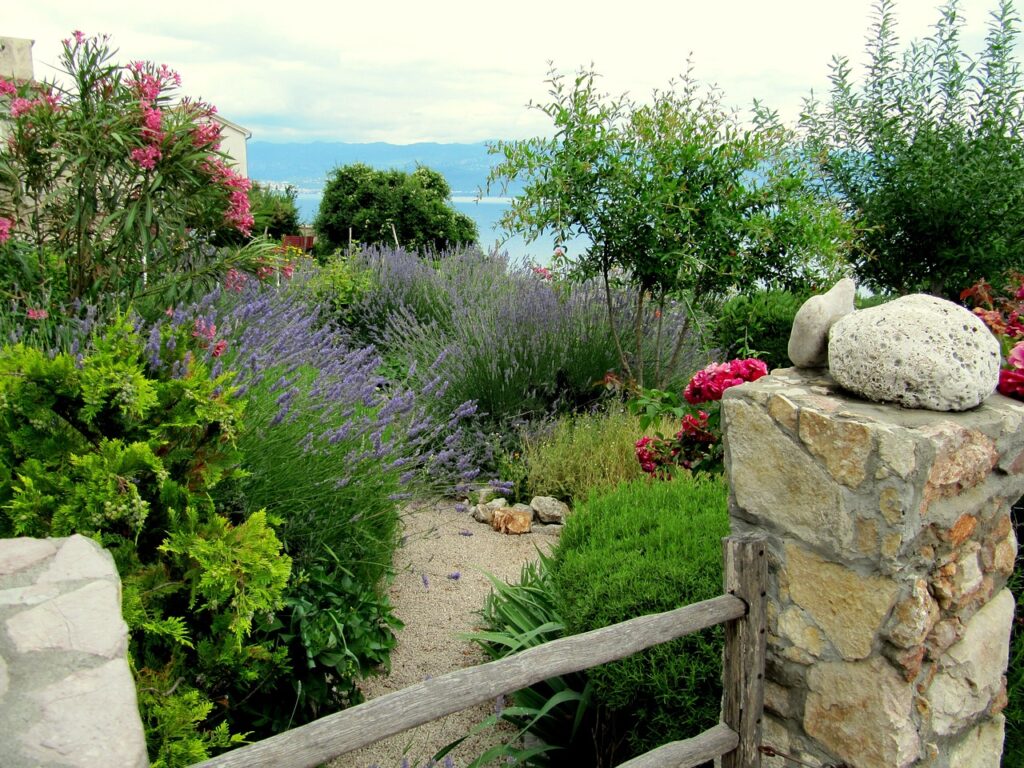
Native plants are naturally adapted to the desert environment and require minimal maintenance.
Benefits of Native Plants:
- Thrive in extreme weather conditions.
- Provide habitat for local wildlife and pollinators.
- Require less water and fertilization.
3. Mix Edible and Ornamental Plants
A successful agriscaped yard seamlessly integrates edible and ornamental plants.
Examples:
- Use pomegranate trees as a striking focal point.
- Plant lavender for its beauty and culinary use.
- Incorporate artichoke plants for their sculptural form and edible buds.
4. Consider Microclimates in Your Yard
Microclimates are small areas within your garden that have different temperature, moisture, and sun exposure levels. Understanding and utilizing these variations can help you plant strategically.
Identifying Microclimates:
- Sunny Areas: Ideal for heat-loving plants like tomatoes and basil.
- Shady Spots: Perfect for leafy greens like lettuce and Swiss chard.
- Protected Zones: Near walls or fences where plants are shielded from wind and extreme temperatures.
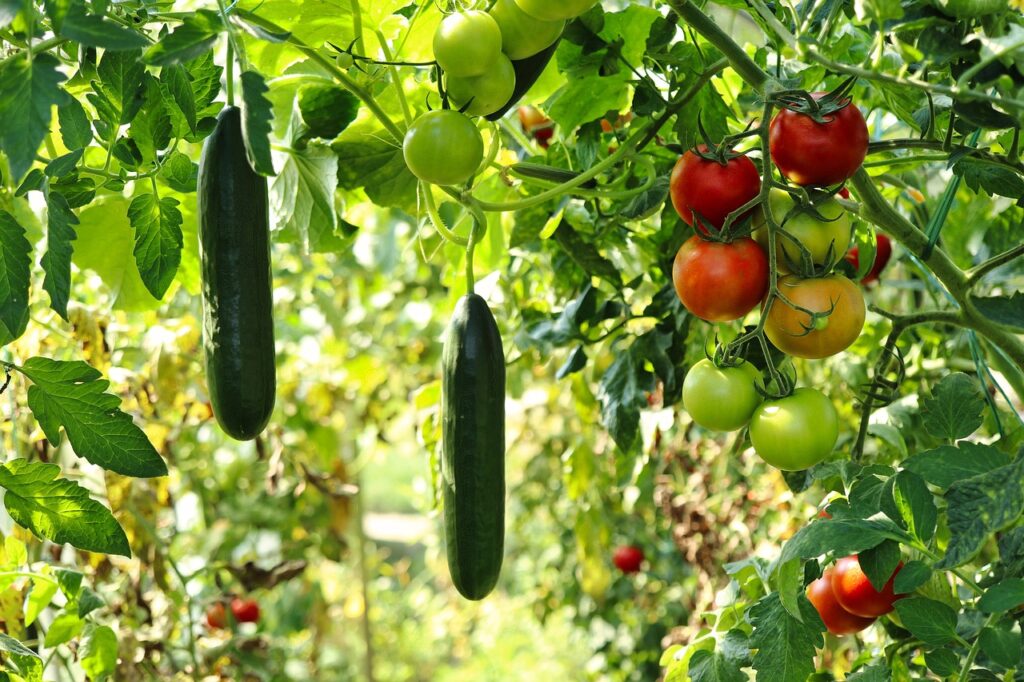
5. Choose Seasonal Plantings
To maintain a productive garden year-round, select plants that thrive in different seasons.
Spring and Summer Picks:
- Tomatoes, peppers, and cucumbers.
Fall and Winter Picks:
- Broccoli, kale, and carrots.
6. Prioritize Pollinator-Friendly Plants
Pollinators like bees and butterflies are essential for a productive garden.
Pollinator-Friendly Choices:
- Sunflowers, milkweed, and zinnias.
- Herbs like basil and mint when allowed to flower.
7. Opt for Companion Planting
Companion planting involves growing plants that benefit each other when planted together.
Examples:
- Tomatoes and Basil: Basil repels pests and enhances tomato growth.
- Corn, Beans, and Squash: The traditional “Three Sisters” method provides mutual benefits.
8. Use Mulch to Conserve Moisture
Mulch helps retain soil moisture, regulate temperature, and suppress weeds.
Tips for Mulching:
- Apply a 2-3 inch layer of organic mulch around plants.
- Use materials like straw, wood chips, or compost.
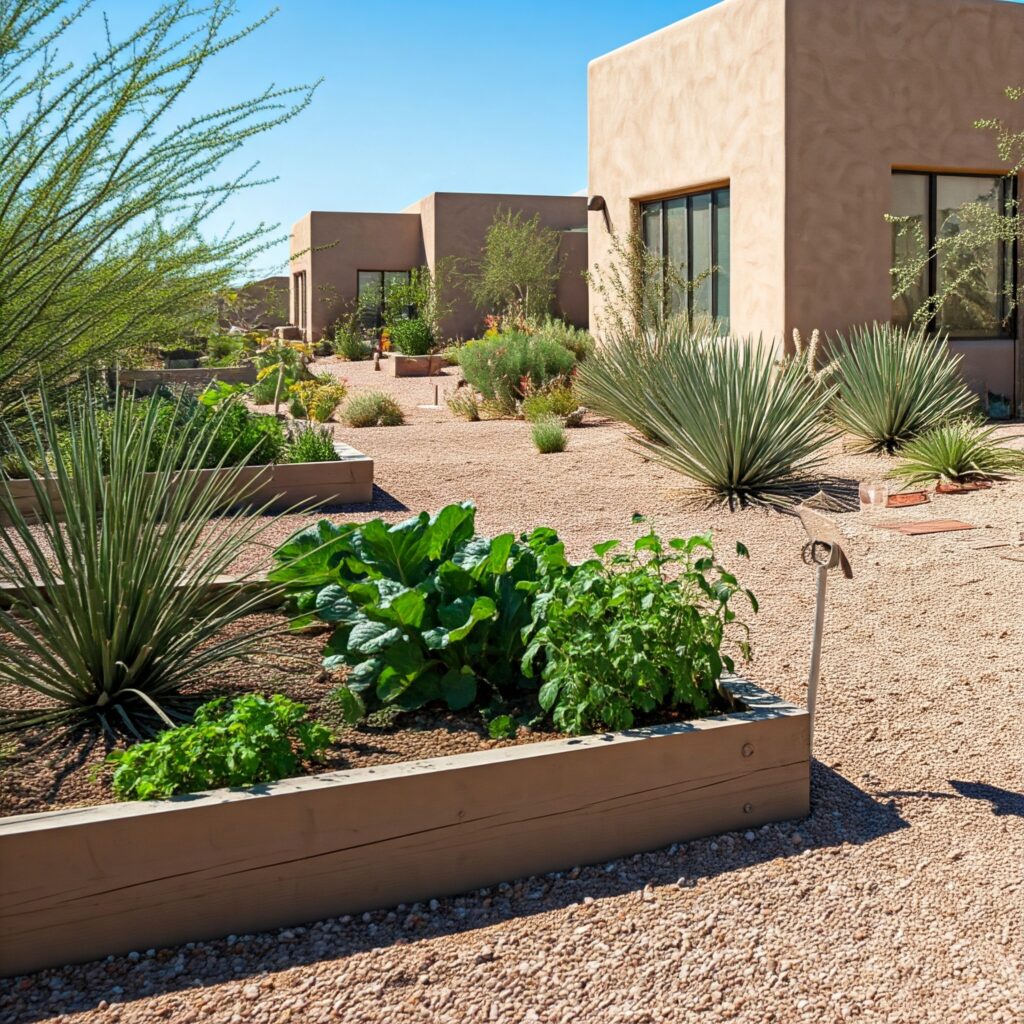
Designing Your Agriscape
1. Create Zones Based on Plant Needs
One of the most effective ways to optimize your desert garden is by creating zones based on plant needs. Grouping plants with similar water, sun, and soil requirements makes it easier to manage irrigation and ensures healthier growth. Each zone can serve a unique purpose within your agriscape.
Example Zones:
- Herb Garden: Place this near the kitchen for convenient harvesting. Choose herbs like basil, thyme, and oregano that thrive in the desert climate with proper care.
- Fruit Tree Orchard: Select a sunny area with well-draining soil for fruit trees like figs, pomegranates, and citrus. These trees need ample sun and benefit from mulch to retain moisture.
- Pollinator Patch: Designate a vibrant section filled with native flowering plants such as desert marigold and globe mallow. These blooms attract beneficial insects and help support the ecosystem.
Grouping plants wisely not only conserves water but also promotes healthier growth by minimizing competition for resources.
2. Incorporate Raised Beds and Containers
Raised beds and containers offer better control over soil quality, irrigation, and drainage. They are particularly useful in desert gardening where soil conditions may be challenging.
Benefits:
- Improved Soil Aeration and Root Growth: Loose, well-draining soil in raised beds promotes strong root systems.
- Easier Maintenance and Harvesting: Raised beds reduce the need for bending and make weeding and harvesting more manageable.
- Enhanced Temperature Control: Soil in raised beds warms up faster in the cooler months and drains efficiently during rare heavy rains.
When choosing containers, opt for those made from durable materials like ceramic or plastic to withstand intense heat. Consider adding mulch on top of the soil to reduce evaporation.
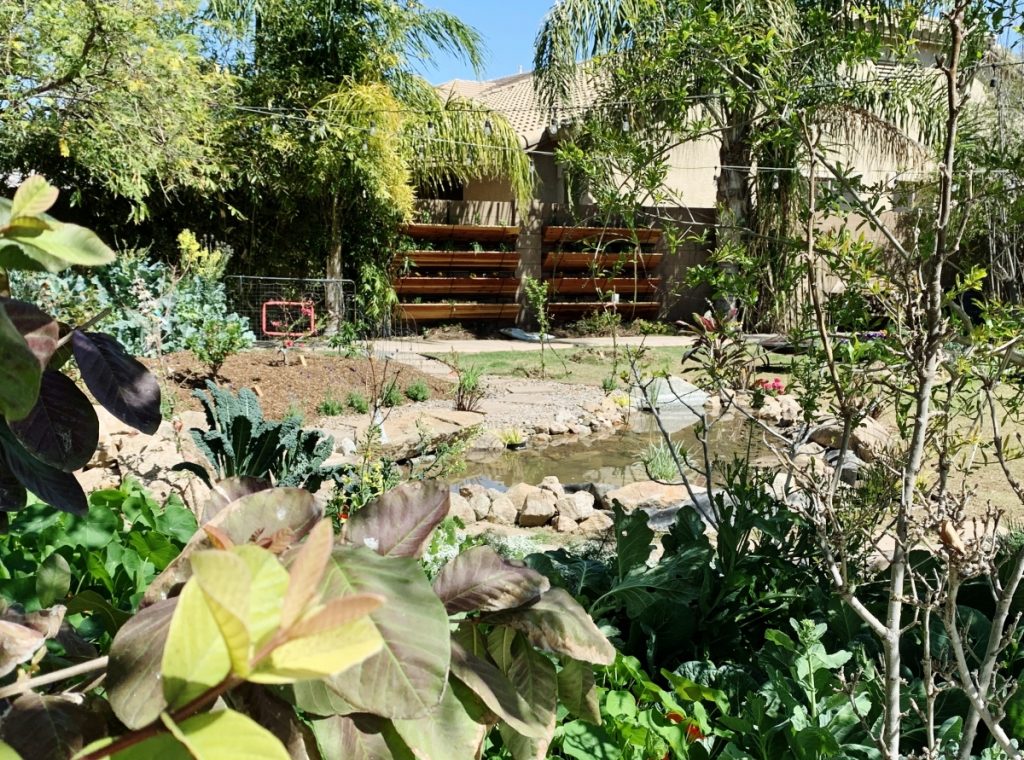
3. Add Vertical Gardening Elements
Maximize your garden space by incorporating vertical gardening techniques. Vertical gardening not only saves space but also helps create visually appealing landscapes.
Ideas:
- Trellises: Use trellises for climbing plants like cucumbers, beans, and even vining flowers. This setup keeps plants off the ground and improves air circulation.
- Wall-Mounted Planters: Install wall-mounted planters for herbs such as mint, parsley, and cilantro. This keeps them within reach and makes efficient use of vertical space.
- Hanging Baskets: Grow trailing plants like strawberries or cherry tomatoes in hanging baskets to add layers to your garden.
Vertical gardening is especially useful in urban or small spaces, allowing gardeners to grow more without compromising on style.
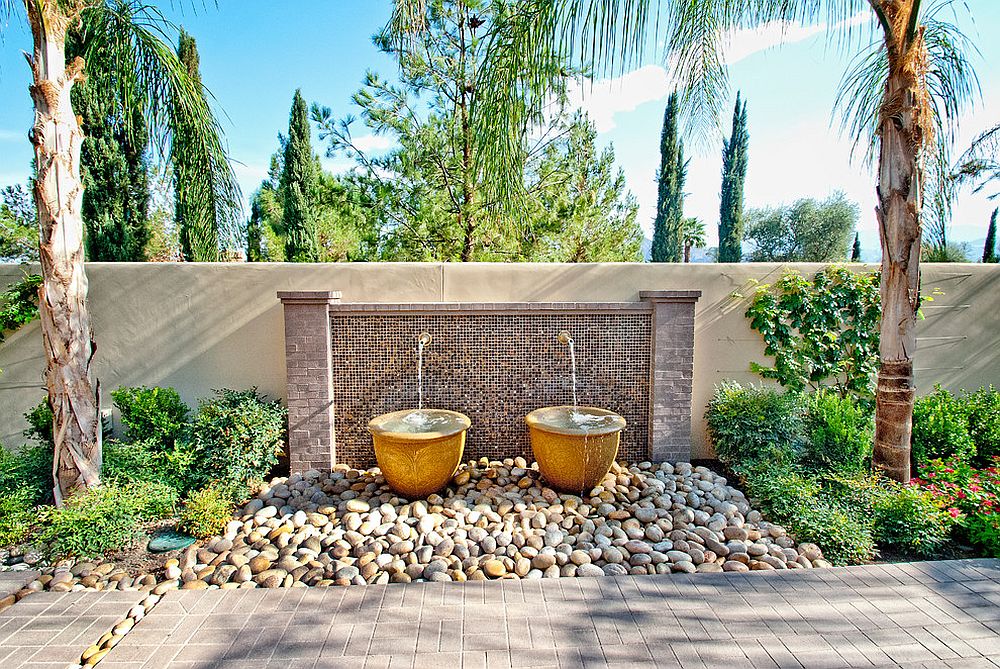
4. Include Water Features Thoughtfully
Water features can enhance the beauty and ambiance of your desert garden while providing cooling effects that benefit both plants and people. However, it’s essential to incorporate them thoughtfully to conserve water.
Tips:
- Recirculating Fountains: Opt for recirculating fountains that reuse water rather than traditional water features. These are more eco-friendly and require less maintenance.
- Strategic Placement: Place water features near shade-loving plants such as ferns or elephant ears to create a microclimate that supports their growth.
- Consider Wildlife: Birdbaths and shallow water features can attract birds and pollinators, enhancing biodiversity in your garden.
Thoughtfully designed water features can transform your desert garden into a tranquil oasis while supporting a healthy, balanced ecosystem.
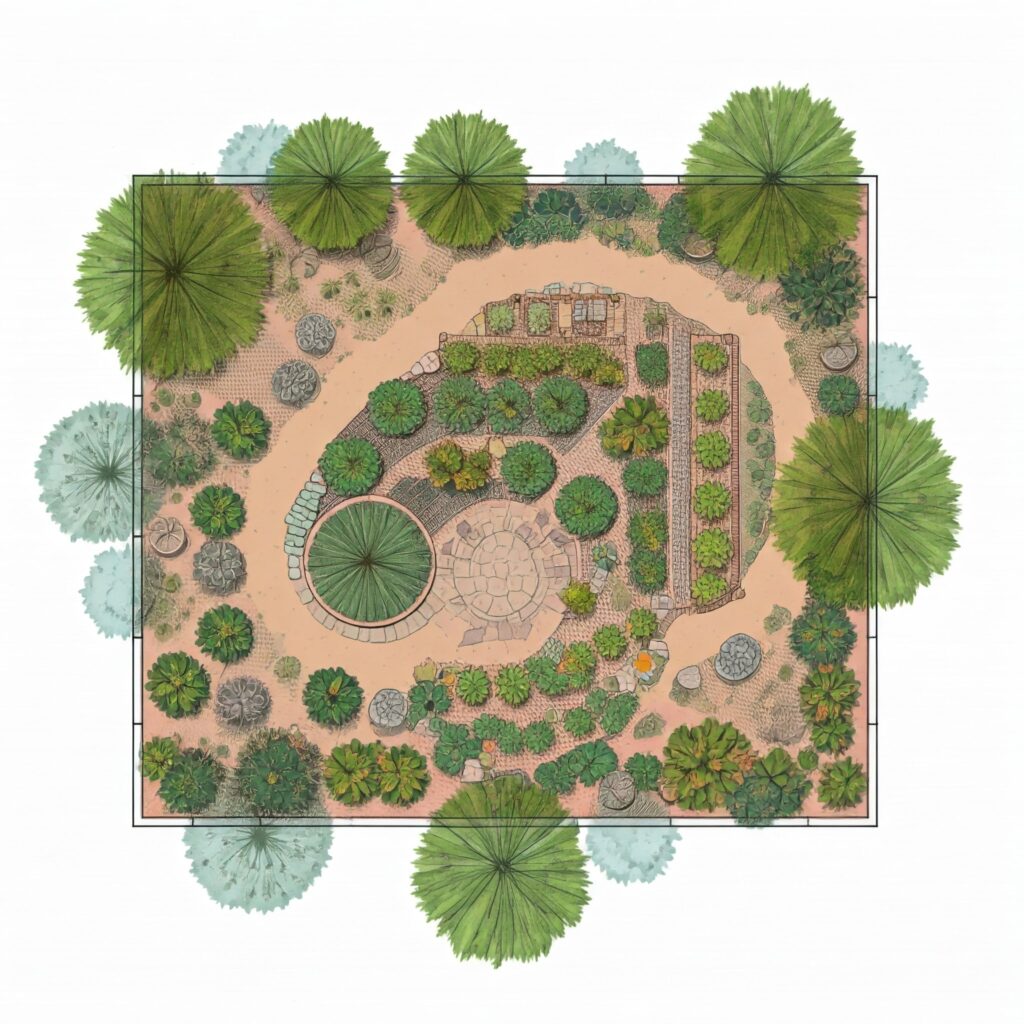
Caring for Your Desert Garden
Creating a beautiful and productive desert garden is only the first step. Ongoing care is essential to ensure your plants thrive year-round.
1. Efficient Irrigation
Water conservation is crucial in desert gardening. Proper irrigation methods help minimize water waste while keeping plants healthy.
Best Practices:
- Drip Irrigation: Deliver water directly to plant roots using drip irrigation systems. This method reduces evaporation and ensures efficient water usage.
- Morning Watering: Water plants early in the morning when temperatures are cooler to reduce evaporation and allow plants to absorb moisture.
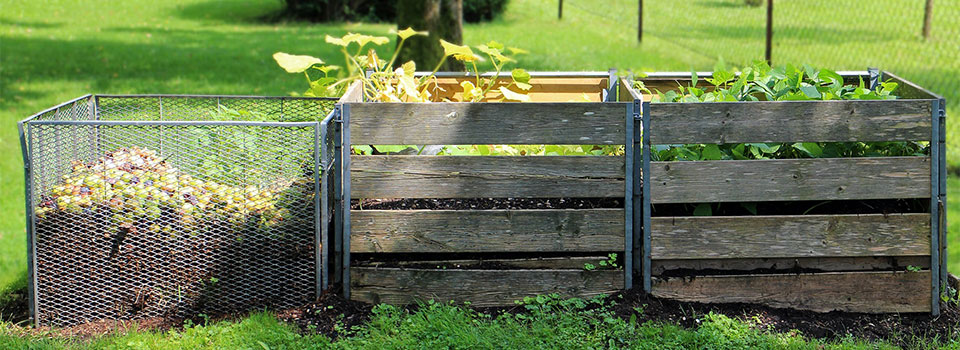
2. Regular Soil Enrichment
Healthy soil is the foundation of a productive garden. Nutrient-rich soil promotes strong plant growth and increases yield.
Tips:
- Add Compost: Regularly incorporate compost to improve soil fertility, structure, and water retention.
- Soil Testing: Test soil pH and nutrient levels to ensure your plants get the right balance of minerals. Adjust with natural amendments if necessary.
3. Pruning and Maintenance
Routine pruning and maintenance keep your garden healthy and productive.
Guidelines:
- Remove Dead or Diseased Growth: Promptly cut away dead, damaged, or diseased branches to prevent the spread of pests and diseases.
- Thin Fruit Trees: Thin out excess fruit to encourage the development of larger, healthier produce.
- General Upkeep: Regularly weed and clean garden beds to maintain a tidy and pest-free environment.
4. Pest and Disease Management
Desert gardens can attract pests and are susceptible to certain diseases. Proactive monitoring and natural solutions help maintain plant health.
Natural Solutions:
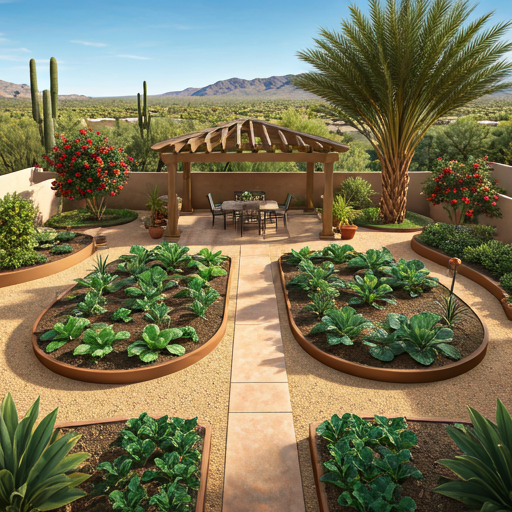
- Beneficial Insects: Introduce beneficial insects like ladybugs and lacewings to control aphids and other pests naturally.
- Neem Oil: Use neem oil as an organic pest control solution for common garden pests.
- Crop Rotation: Rotate crops each season to reduce the buildup of soil-borne pests and diseases.
By following these care practices, you can maintain a thriving and beautiful desert garden that continues to yield fresh produce and blooms year after year.
Conclusion
Desert gardening becomes a rewarding experience when you choose the right plants and apply agriscaping principles. By blending edible and ornamental plants, considering microclimates, and prioritizing sustainability, you can create a beautiful and productive landscape that thrives in the desert southwest. With thoughtful planning and care, your agriscaped yard will not only enhance your property’s aesthetics but also provide fresh produce and environmental benefits year-round. Start your agriscaping journey today and enjoy the best of both ornamental beauty and agricultural bounty.
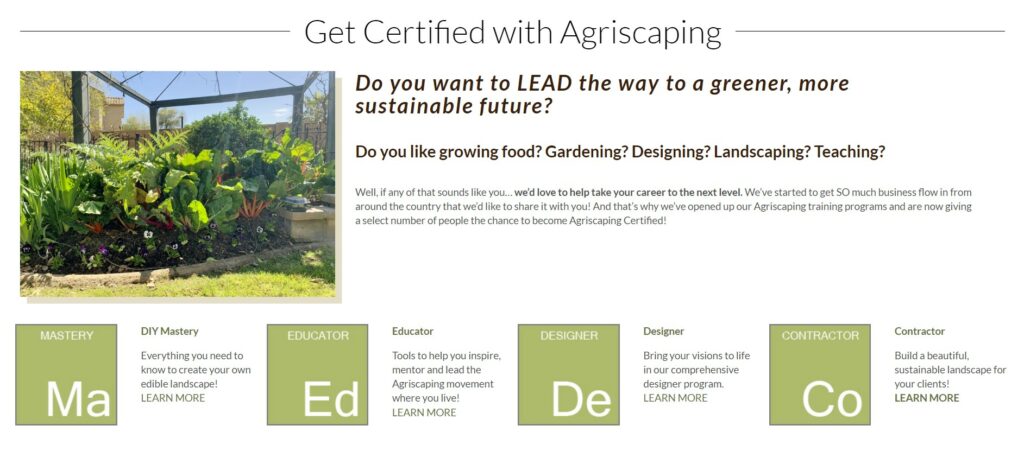
Read Our Latest Posts…
- Start the New Year with a Thriving Edible Landscape
 Expert tips for desert gardening, from plant zoning and efficient irrigation to soil care and agriscaping for a sustainable landscape.
Expert tips for desert gardening, from plant zoning and efficient irrigation to soil care and agriscaping for a sustainable landscape. - Understanding Freeze Pruning
 Expert tips for desert gardening, from plant zoning and efficient irrigation to soil care and agriscaping for a sustainable landscape.
Expert tips for desert gardening, from plant zoning and efficient irrigation to soil care and agriscaping for a sustainable landscape. - A Garden-Fresh Christmas: Agriscaping Tips for a Festive and Sustainable Holiday
 Expert tips for desert gardening, from plant zoning and efficient irrigation to soil care and agriscaping for a sustainable landscape.
Expert tips for desert gardening, from plant zoning and efficient irrigation to soil care and agriscaping for a sustainable landscape. - 7 Garden Design Themes for Your Elegant Edible Landscape
 Expert tips for desert gardening, from plant zoning and efficient irrigation to soil care and agriscaping for a sustainable landscape.
Expert tips for desert gardening, from plant zoning and efficient irrigation to soil care and agriscaping for a sustainable landscape. - Subterranean Trampoline Gardens: A Hidden Oasis for Growing and Playing
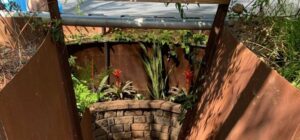 Expert tips for desert gardening, from plant zoning and efficient irrigation to soil care and agriscaping for a sustainable landscape.
Expert tips for desert gardening, from plant zoning and efficient irrigation to soil care and agriscaping for a sustainable landscape.
